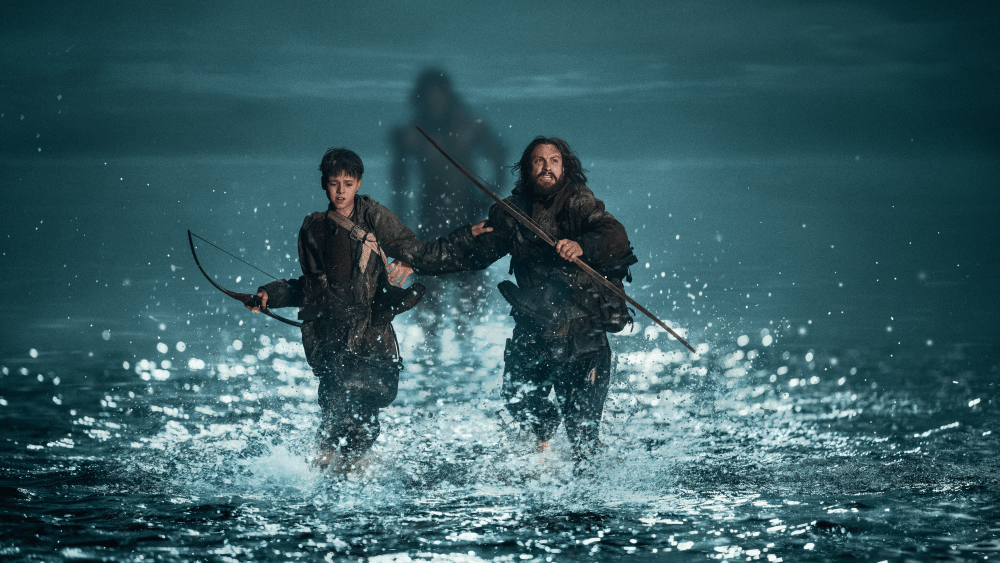Run!
Danny Boyle’s “28 Years Later” features one of the most heart-stopping chase sequences of the year. In the film, Jamie (Aaron Taylor-Johnson) and his son Spike (Alfie Williams) have headed to the mainland and already encountered the infected, including the evolved variant known as The Alpha. Alphas are bigger and stronger. One, named Samson, rips his victims’ heads off.
After their hunt-and-kill mission, the two head back home. But their only way back is via the causeway back to Holy Island. The tide is low enough for them. But as they make their way across, The Alpha appears and a chase ensues with Jamie and Spike running for their lives, while The Alpha remains hot on their tails.
Filming took place around Holy Island, Newcastle and North Yorkshire in England, but finding and filming the causeway for the sequence proved to be anything but easy.
Cinematographer Anthony Dod Mantle and the production team did location scouts around the coast of Newcastle. While one location seemed a possibility, Dod Mantle and the producers feared the environment “was going to be difficult to control. The water could be unsafe to run in, or they could break a leg,” he says.
At the time of filming, Williams was 13 years old, which meant his working hours were restricted, and that too posed a challenge since they wouldn’t be able to shoot during the hours they wanted to.
Dod Mantle says, “We ended up in an ex-COVID vaccination center just outside of Newcastle.” He continues, “It was a gigantic hall.”
As soon as Dod Mantle saw the location, he could envision the water causeway, and it opened up a wealth of possibilities. “We built it ourselves, filled it up with water and it was temperature controlled.” He adds, “We built this whole set, which was 450 feet long with the gate in the middle, and we had to light it.”
Dod Mantle used VFX to help fill and light the sky. “We achieved it through plates that we got from an astronomy center. We’d sourced a lot of images that we liked.” He leaned towards the luminance in the sky. “So I had to light it with that in mind.
The lights weren’t actually the Northern Lights, says Dod Mantle. “We assume, to a certain extent, that 28 years later, there will be no pollution, no cars, no interference. So we have this premise that the air is clean.”
In filming the chase itself, Dod Mantle and Boyle wanted to travel at speed through the water with Jamie and Spike, while the Alpha was close behind. “We had cranes and tracks down the side. I had two dollies working at the same time. I had two technocranes. We had the bar cam, which is the array of iPhones, also on the technocrane, which is a pretty savage decision, because that’s moving at speed, wrapped around the head of Aaron Taylor-Johnson, or the Alpha. It’s pretty scary. But we did it.”
Dod Mantle reckons it took approximately three to four days to shoot and describes the scene as “blissful.” He continues, “It’s an oddly sublime, melancholic, beautiful and yet terrifying scene. I really like the ambiguity and the polarization of beauty, melancholy, or whatever you want, fear, and the genre of horror.”

As for shooting the zombie kills, Dod Mantle admits the use of bows and arrows as weapons “worried me the most, aesthetically.” It was how the infected could be killed: an arrow into the head.
“Danny tapped into something very precise about the simple mode and code of survival, of reorganizing the society and hunting. There are no guns and no bombs. You get a bow and arrow.” Dod Mantle thought of the old Robin Hood films and had seen good arrow scenes: “I was a bit wary and cautious. How is this going to work?”
In the end, Dod Mantle used the bar cameras. “It’s a method of prolonging the moment of a fraction of a second of an arrow entering a body. It also wraps around in a circumference, which is an aesthetic we’ve seen in other films, and it works.”
Dod Mantle comes back to the Alpha on the causeway and shooting that sequence. “I was more terrified than I thought I was going to be on the causeway, because when he was pounding down behind me and pounding towards us, it was pretty terrifying and the use of sound, and the way we shot it and lit it was terrifying.”

The film also introduces the bottom feeders, the Slow-Lows. These feed on anything leftover from the Infected. “They’re a new introduction of fear. It’s not about speed and shaking arms and shutter movements. It’s about the apparent stealth,” Dod Mantle says. “No one would think of them as dangerous because they’re eating worms on the ground, and not as threatening as one might imagine.”
The first time Dod Mantle saw them was while Boyle was in London during prosthetics testing. “They were made up for six hours every day, so he sent me a picture.” He adds, “I couldn’t wait to get cameras onto that so you feel you’re moving with the body.”
Dod Mantle points to one scene when Jamie is in the bone temple church with his mother, played by Jodie Comer. In the scene, Jamie and his mom have escaped to the mainland. Jamie wants to take her to a doctor and they take refuge in an abandoned church. In the middle of the night, a Slow-Low creeps closer and closer.
“That’s my worst nightmare. He’s about to take his head off, and they’re blind. They can’t see, but they can smell. That’s why the Slow-Low thinks Jamie’s shoelace is a worm, and he spits it out.” Dod Mantle says. “It’s a lovely detail. There’s comedy there, but they’re the ones that scare me. I think that’s Danny’s very competent attention to this genre. He’s clever.”

No responses yet